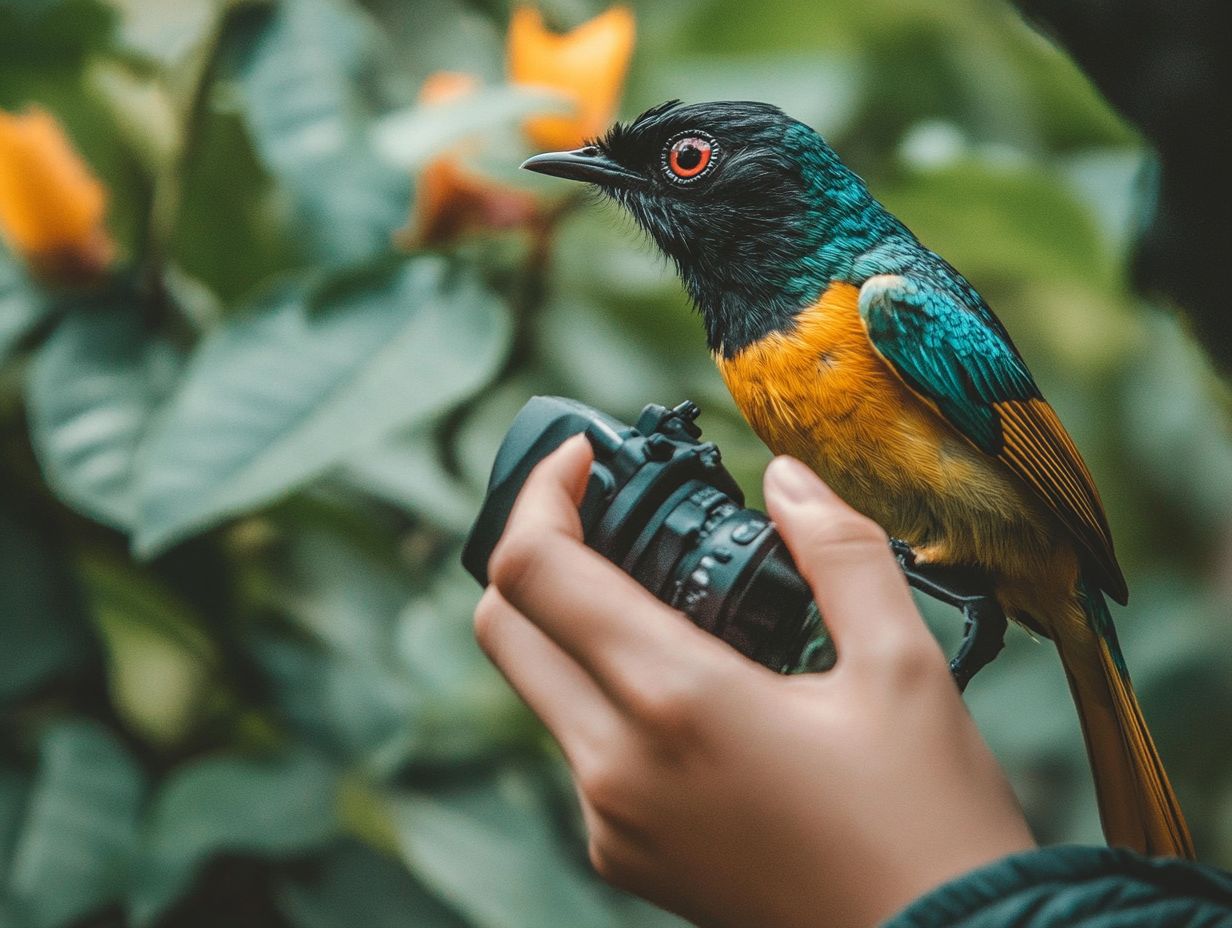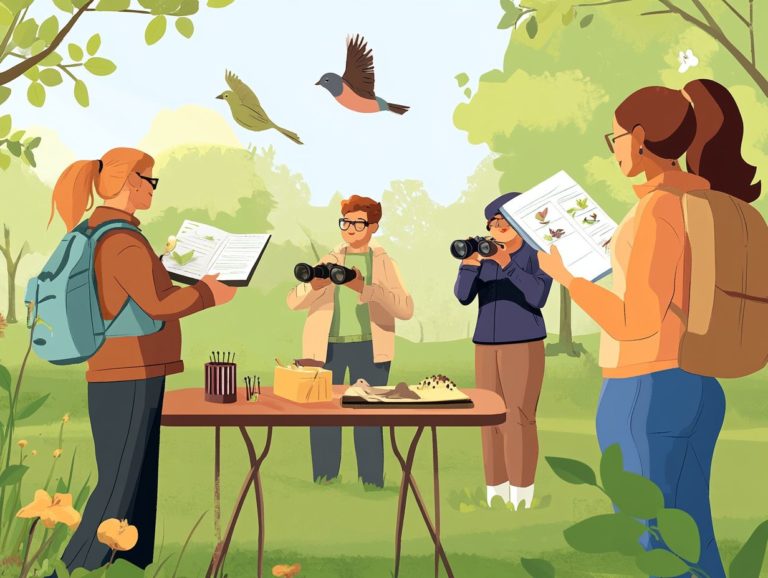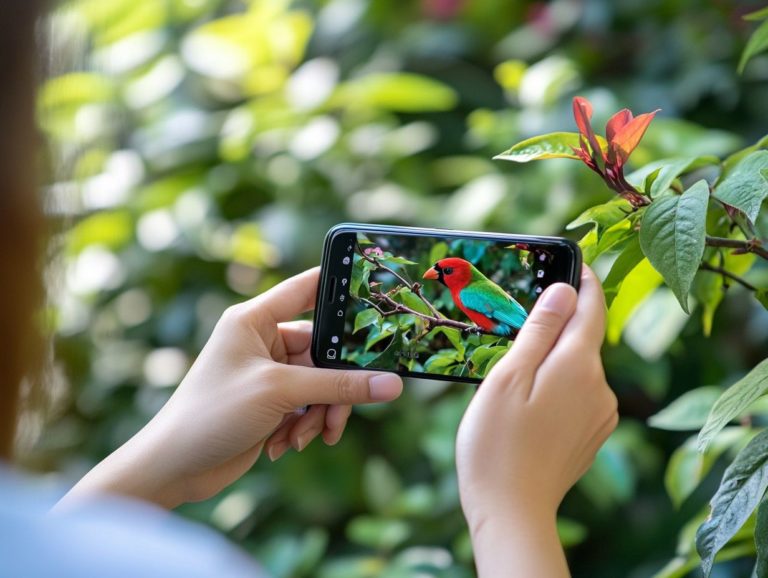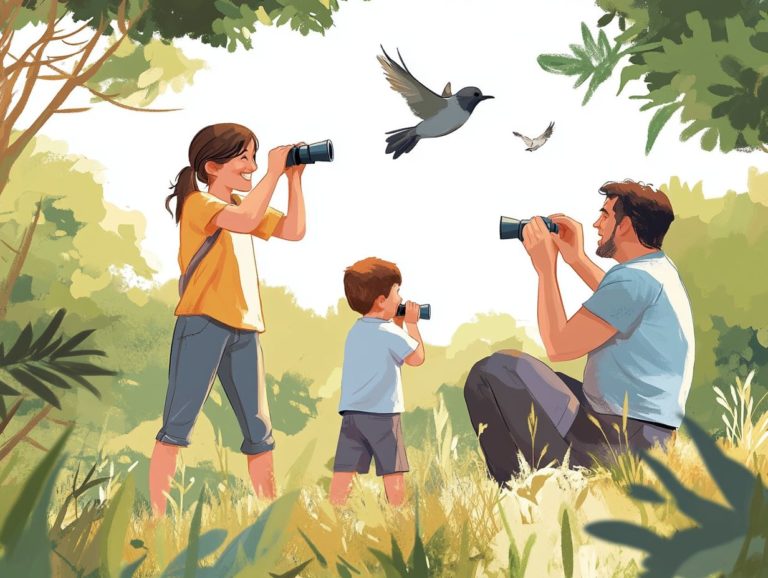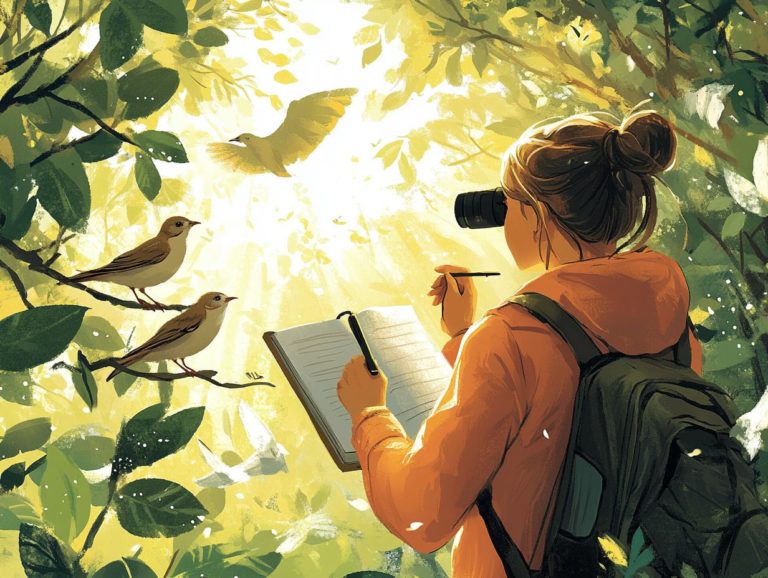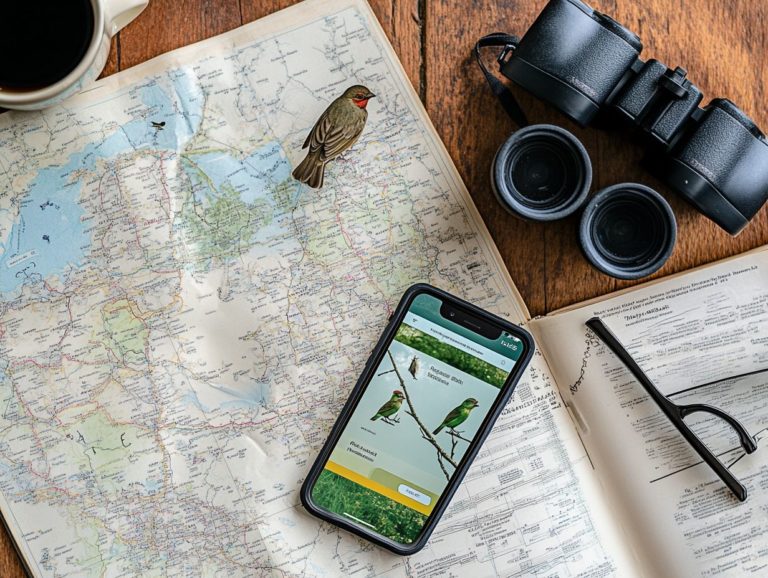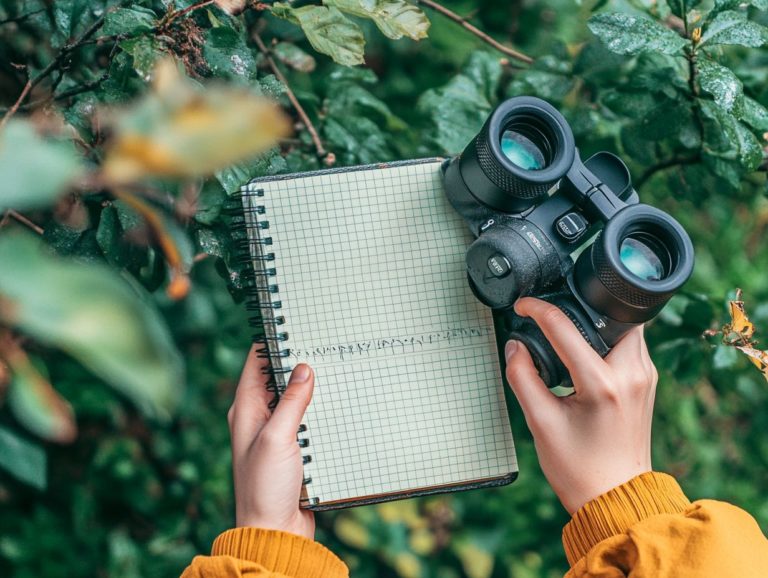How to Safely Photograph Birds in the Wild?
Photographing birds in the wild is more than just a fun hobby; it s an art form that forges a deep connection with nature.
Whether you re just beginning your photography journey or have years of experience, capturing the exquisite beauty of these magnificent creatures demands the right gear, honed techniques, and a steadfast commitment to safety.
This article delves into essential camera equipment, effective photography strategies, and crucial safety precautions that will elevate your experience while respecting the environment.
You ll also discover valuable resources that will enrich your bird photography adventure!
Contents
- Key Takeaways:
- Essential Gear for Bird Photography
- Techniques for Photographing Birds in the Wild
- Safety Precautions for Photographing Birds
- Resources for Learning More About Bird Photography
- Frequently Asked Questions
- What is the best way to safely photograph birds in the wild?
- How can I make sure I am not disturbing the birds when taking photos?
- Are there any specific times of day that are better for bird photography?
- What safety precautions should I take when photographing birds in the wild?
- Can I use flash when photographing birds in the wild?
- What should I do if a bird approaches me while I am photographing?
Key Takeaways:
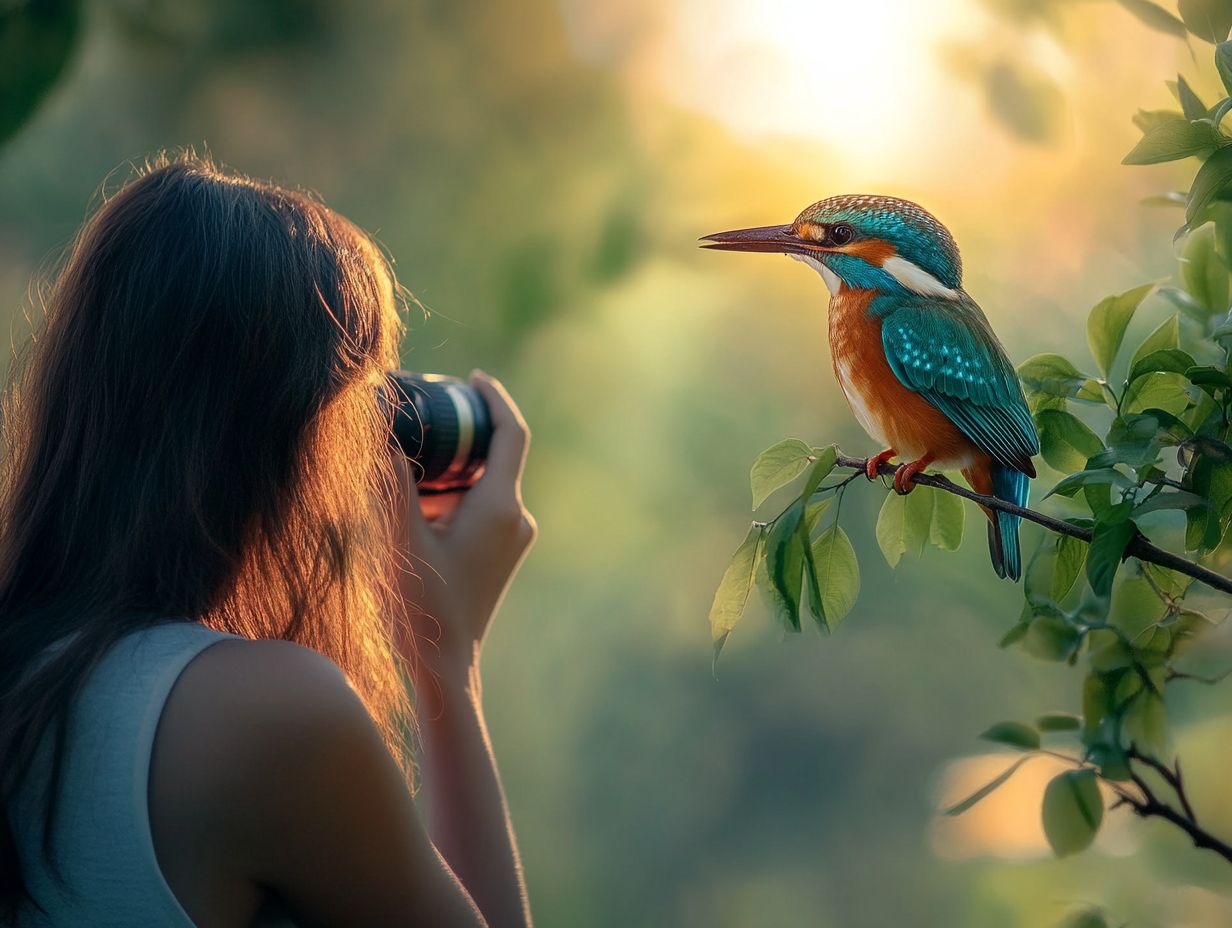
- Invest in the right gear for bird photography, including a suitable camera and lens, to capture high-quality photographic images in the wild.
- Practice proper composition and lighting techniques to capture stunning photos of birds in their natural habitat.
- Prioritize safety when photographing birds by respecting their space and environment, as well as protecting yourself and your equipment.
Benefits of Photographing Birds in the Wild
Photographing birds in the wild offers you a wealth of benefits that go far beyond simply capturing stunning images. It fosters a deeper connection to nature.
It enhances your understanding of avian behaviors and promotes ethical wildlife photography. You ll find yourself exploring diverse habitats where these magnificent species thrive.
Wildlife photography serves as an expressive outlet for your creativity while playing a crucial role in conservation efforts by raising awareness about the importance of preserving natural ecosystems. The thrill of patiently waiting for a bird to reveal its behavior, paired with the satisfaction of clicking the shutter at just the right moment, creates an exciting and educational adventure!
Engaging in this art form allows you to develop a deeper appreciation for the intricate details of bird life, from their unique plumage to their complex social interactions. As you hone your skills in composition and lighting, you will uncover not only the technical aspects of capturing the perfect shot but also a profound respect for the delicate balance of life within various ecosystems.
This journey encourages continuous observation, revealing how different species adapt to their surroundings and their vital roles in the environment.
Ultimately, these experiences can inspire personal growth and a commitment to wildlife conservation, instilling in you a sense of responsibility to protect these creatures and their habitats for future generations, ensuring that they also have the opportunity to engage in wildlife photography.
Essential Gear for Bird Photography
Equipping yourself with the essential gear for bird photography is vital for capturing breathtaking images that highlight the elegance of avian species in their natural habitats.
This involves carefully selecting the ideal camera and lens combination, mastering how shutter speed (the length of time the camera s shutter is open to let in light), exposure, and focal length influence your shots, and embracing manual mode to adapt seamlessly to shifting light conditions.
Camera and Lens Selection
Choosing the right camera and lens for bird photography is essential for capturing vibrant images. Brands like Sony, Nikon, Fujifilm, and Olympus offer a variety of models that cater to different skill levels and preferences. Your lens selection can greatly impact your ability to zoom in on subjects and freeze action at the right shutter speeds.
To make an informed decision, evaluate key features like ISO sensitivity, which enhances your performance in varying lighting conditions. Consider the type of camera you want to use DSLRs feature traditional viewfinders, while mirrorless models are known for their compactness and quick autofocus.
The Nikon D500 is a robust DSLR with excellent high ISO performance. In contrast, the Sony A7R IV is a popular mirrorless option with impressive dynamic range, suitable for various light conditions.
Lens selection is equally important. A fast aperture, like f/2.8, allows more light into the lens, paired with a focal length of 300mm or more, can ensure sharp images from a distance. Consider options like the Canon EF 300mm f/2.8L IS II USM or the Sony FE 200-600mm f/5.6-6.3 G OSS to elevate your bird photography experience.
Other Useful Equipment
Along with your camera and lens, investing in essential gear can enhance your bird photography experience. A sturdy tripod is crucial for stabilizing shots, especially in low light conditions. Additionally, learning how to use natural light in bird photography allows fine-tuning of exposure to capture perfect images without disturbing wildlife.
Incorporate high-quality filters to reduce glare and improve color saturation. A reliable selection of memory cards ensures you won’t miss a moment due to storage limitations. Cleaning kits are essential for maintaining your gear in top shape, particularly in outdoor settings where dust and moisture can be a challenge.
With all this gear at your disposal, adhere to ethical photography practices. For those interested in capturing stunning images, following tips for photographing rare bird species is crucial. Keeping a respectful distance from birds minimizes stress on their natural behavior and habitat. This approach preserves wildlife integrity and enriches your experience.
Techniques for Photographing Birds in the Wild
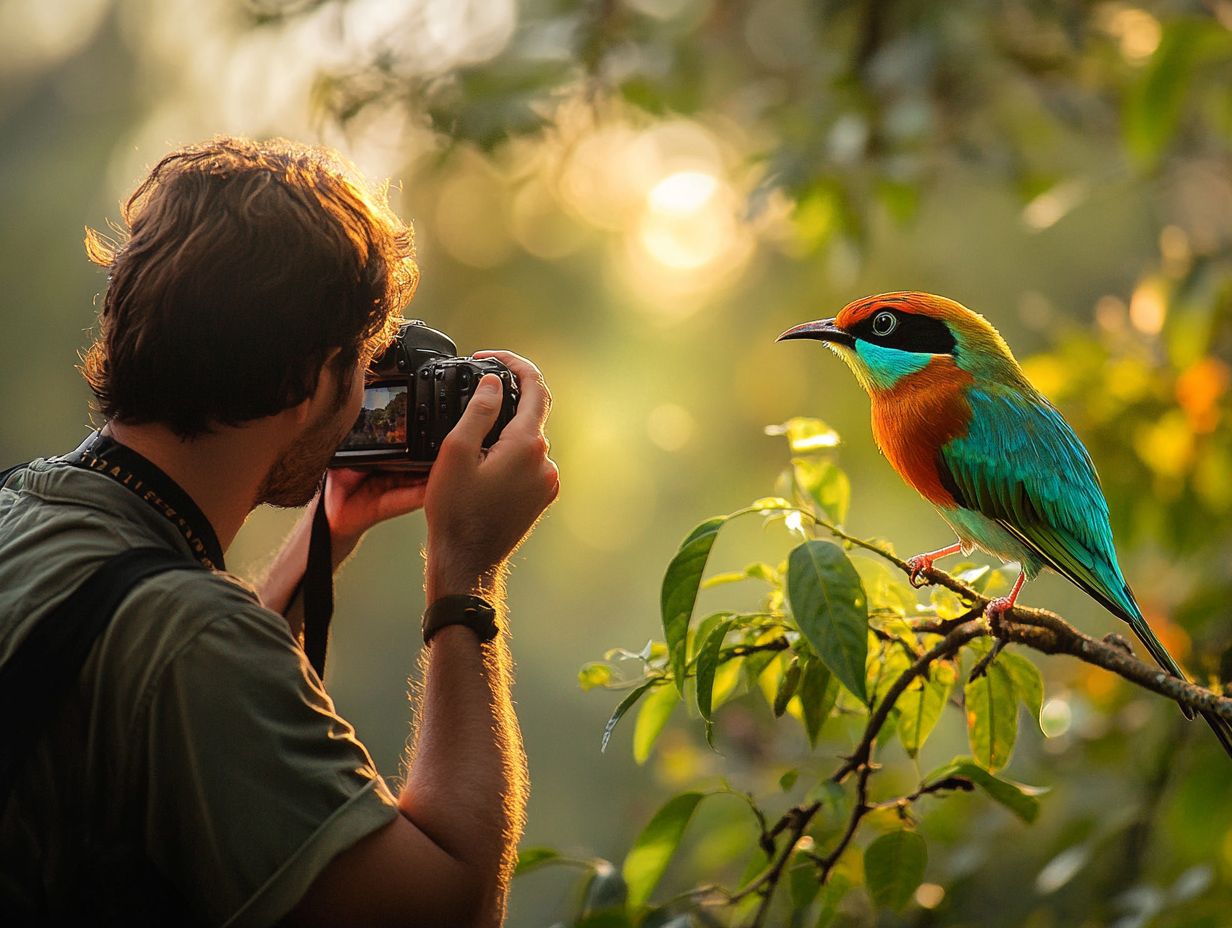
Mastering the art of photographing birds in the wild is vital for capturing breathtaking images that showcase the beauty of avian life. However, it’s also important to consider safety precautions while birding. Whether diving into composition, leveraging natural light, or fine-tuning camera settings, each element impacts your wildlife photography.
Embrace these techniques and elevate your skills to new heights!
Composition and Lighting Tips
Effective composition and lighting can significantly improve your bird photography. By considering the background and utilizing various lighting conditions, you can create striking images that highlight your subjects.
Techniques like leading lines guide the viewer’s eye to the bird, while framing adds depth and context. For instance, placing a bird within a natural frame, like branches or foliage, enhances the photograph’s aesthetic appeal.
Experiment with different times of day; the golden hour right after sunrise or just before sunset offers soft, warm light that beautifully illuminates feathers. This approach enriches the storytelling aspect of your work.
Grab your camera and start exploring the beauty of bird photography today!
Camera Settings and Techniques
Understanding camera settings is essential for bird photography. These techniques can make or break your images.
Adjusting the ISO, aperture (the opening in your camera that controls light), and shutter speed can dramatically influence your final images. This allows you to capture fast-moving subjects and intricate behaviors in their natural habitat.
By mastering these adjustments, you can easily adapt to varying light conditions. This helps you highlight the unique characteristics of your feathered subjects.
For instance, setting a higher ISO can produce clearer images in dim light. However, be cautious if you push it too high, you might introduce unwanted noise.
On the other hand, using a wider aperture creates that lovely background blur, drawing attention to the bird, but it also requires careful thought about depth of field (how much of your photo is in focus).
For action shots, cranking up the shutter speed is crucial; this minimizes motion blur and ensures sharp detail. In bright light, a faster shutter speed can freeze a bird mid-flight, resulting in stunning clarity.
Know when to adjust these settings for different scenarios. This will greatly improve your bird photography.
Safety Precautions for Photographing Birds
Implementing safety precautions while photographing birds is crucial. This is important not just for your safety but also for the well-being of the wildlife you pursue, including strategies on how to stay hidden while bird photography.
By understanding and adhering to the ethical guidelines of wildlife photography, you ensure that you respect both your subjects and their habitats. This minimizes any potential disturbance.
Respecting Wildlife and Their Habitat
Respecting wildlife and their habitats is a cornerstone of ethical photography. By minimizing disturbances and understanding bird behaviors, you can help conserve avian species and enhance your skills with techniques for photographing birds in flight.
For instance, getting too close to nests or feeding territories can stress the birds. It might even lead to the abandonment of their young.
It’s essential to maintain a respectful distance, allowing these magnificent creatures to carry on with their natural routines unhindered.
Being well-informed about local wildlife regulations is crucial. These laws often outline how close you can get to nests and other sensitive areas.
By following these guidelines, you protect the delicate ecosystem and enhance your experience, capturing wildlife in its most authentic form.
Protecting Yourself and Your Equipment
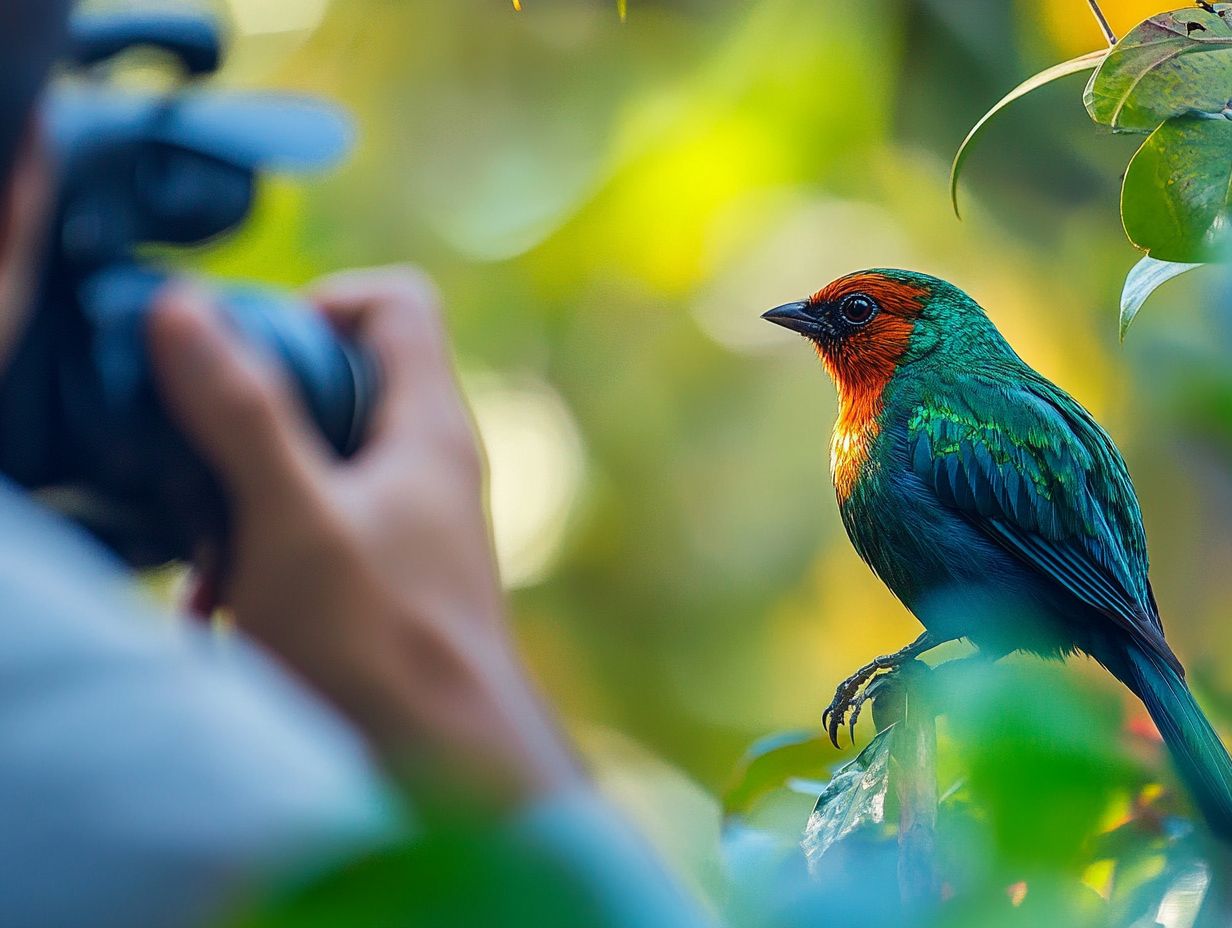
In wildlife photography, protecting yourself and your equipment is absolutely essential. Stay alert and gear up! A sturdy tripod and weather precautions are your best friends in protecting both you and your equipment.
To elevate this protection, consider utilizing weather-sealed cameras. This can be a game changer when sudden downpours or dusty conditions strike.
Employing lens covers is another smart move; they prevent scratches and dirt buildup, ensuring your shots remain crystal clear.
Carrying your gear in protective cases not only adds a layer of security but also simplifies transporting your equipment through rugged terrains.
When you venture into wildlife territory, remember to maintain a respectful distance and stay calm. Keeping an eye on your surroundings is crucial to avoid startling animals. This ensures both your safety and the serenity of nature.
Resources for Learning More About Bird Photography
Exploring a diverse range of resources can significantly elevate your skills and appreciation for this captivating art form.
Whether you choose to attend workshops, delve into insightful literature, or engage with online communities, each option offers invaluable insights that can inspire your journey as an aspiring photographer.
Now that you understand the essentials, grab your camera and start capturing the beauty of birds in action!
Books, Workshops, and Online Communities
Books, workshops, and online communities are invaluable resources for you as you refine your bird photography skills. Well-curated books offer deep insights and knowledge. Hands-on workshops provide practical experience and the chance to network with fellow enthusiasts.
These elements come together to create a supportive environment that nurtures both learning and creativity. Notable titles like *The Art of Bird Photography* illuminate essential techniques and equipment. Engaging workshops often led by seasoned professionals allow you to practice in breathtaking natural settings.
Popular online platforms like Flickr and Instagram are vibrant spaces where you can showcase your work, connect with mentors, and receive constructive critiques from a lively community. Engaging in forums dedicated to bird photography can further enhance your skills and inspire fresh perspectives.
Frequently Asked Questions
Here are some common questions about bird photography:
What is the best way to safely photograph birds in the wild?
The best way to safely photograph birds in the wild is to maintain a safe distance from the birds and their nests. For tips on achieving this effectively, check out our guide on how to take photos while bird watching. Use a long camera lens that helps you take close-up pictures without getting too close to the birds.
How can I make sure I am not disturbing the birds when taking photos?
Watch the birds closely! Their behavior can tell you a lot about how to approach them safely. If the birds show signs of distress, such as squawking or flying away, back off and give them space.
Are there any specific times of day that are better for bird photography?
The best times of day for bird photography are usually early in the morning or late in the afternoon when lighting is softer and birds are more active. Avoid taking photos during the middle of the day when the sun is directly overhead, as it can create harsh shadows.
What safety precautions should I take when photographing birds in the wild?
Always be aware of your surroundings and stay alert for potential hazards, such as uneven terrain or nearby predators. Dress appropriately for the weather to stay comfortable while you shoot, and bring along necessary supplies like insect repellent and sunscreen.
Can I use flash when photographing birds in the wild?
Using flash when photographing birds in the wild is not recommended as it can startle or disorient them. It can also cause red-eye in the photos and may not produce the most natural-looking images.
What should I do if a bird approaches me while I am photographing?
If a bird approaches you while you are photographing, stay calm and try not to make any sudden movements. It is likely just curious and will fly away once it realizes you are not a threat. For tips on how to prepare for such moments, check out this guide to preparing for a bird photography outing. If the bird appears agitated, slowly back away and give it space.
Get ready to explore these amazing resources and elevate your bird photography skills!

